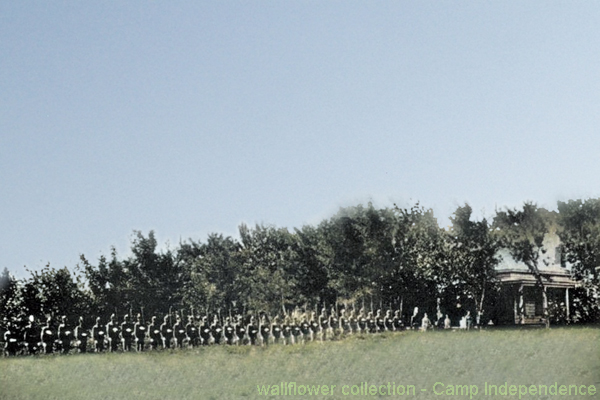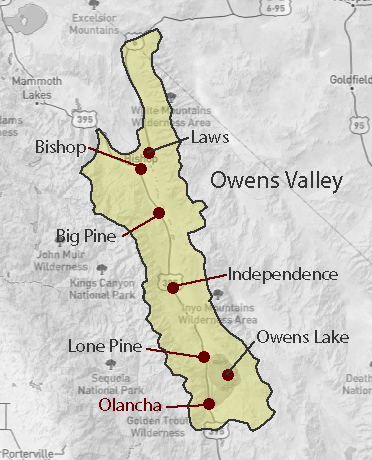Camp Independence

Camp Independence (colorized, messed with)
Situated in Inyo County on the north side of Oak Creek, about three miles from the town of Independence, in the Owens River Valley, on the eastern slope of the Sierra Nevadas the post was established by Lieutenant Colonel George S. Evans 2nd California Cavalry on July 4, 1862 Never officially designated a fort, it was established to provide protection for the area's miners, who were troubled by Indian marauders. Temporarily abandoned in 1864, it was reoccupied in March 1865, due to renewed Indian depredations. The post was finally abandoned on July 5, 1877. The military reservation was transferred to the Interior Department for disposition on July 22, 1884.
History
by Colonel Herbert M. Hart, USMC (retired)
Executive Director, Council on America's Military Past
Even 140 years later, Native Americans in California's Owens Valley still recall with bitter reluctance the darkest day in their relations with the whites.
The date was July 10, 1863, the place, year-old Camp Independence. Throughout the day tribesmen in the area had answered the summons to the post issued by Captain Moses A. McLaughlin, previously the relentless commander of Camp Babbitt.
When more than 1,000 Native Americans were gathered on the parade ground, McLaughlin called the chiefs to the center and ordered the others to sit on the ground. Through an interpreter, he informed them that they were to be tip-rooted from their native hunting grounds and marched 200 miles southwest to abandoned Fort Tejon. He knew they would react unfavorably and was prepared.
"I had taken the precaution to have the troops so stationed that their presence did not excite the suspicions of the Indians," be reported, "and yet at the time I made the announcement they were completely surrounded ... During the night the troops slept upon their arms on the parade ground, ready at a moment's notice to prevent any attempt at escape.
The Indians knew it was hopeless, as expressed by their chief: "American capitan sabe much, Indian poco."
Seventy soldiers guarded the sorrowful procession when it started the next morning. Only a few wagons were available for some of the women and children. The mid-summer weather was unbearably hot. "The sufferings upon the route were intense" understated McLaughlin. The fact that only 850 Indians finished the trek spoke more eloquently of the hardships. Escape for some, death for others had taken their toll from the total.
Months later, most of the survivors had returned to the Owens Valley. Fort Tejon bad been unbearable under McLaughlin and a disinterested Indian agent. By January, 1864, only 380 Indians were left. In another six months, department headquarters announced that because "there were no longer any Indians in the vicinity of Fort Tejon, that the post will be abandoned."
It was small consolation to the refugees that six months after their merciless march, McLaughlin would be relieved of his command and face court martial. This was an old story to him; at least once before charges bad been placed against him "for cruelly beating and maltreating" one of his troopers.
McLaughlin had come to Independence as a confirmed Indian hater, as a massacre of 35 while at Camp Babbitt attested. Local tradition places some of the blame for his actions on alcohol, and one story suggests that be did not confine his anger to Indians when his patience was tried.
On one occasion, the tale goes, his drinking was disturbed by general restlessness in the corral. He ordered two soldiers to shoot every horse that was moving around. Men they refused to obey, lie had them put in the guardbouse, from which they escaped by removing the binges. Once they had put McLaughlin far behind them, they turned themselves in at another Army post.
The conditions at Independence may have bad something to do with the unsavory situation. When it was established in 1862 a California cloudburst signalled the occasion, somewhat dampening the spirits of the men. Regardless, when a 50-foot flagpole was erected "and the old flag with all of the stars upon it hoisted to the breeze," Lieutenant Colonel George S. Evans could report there were "three times three given most heartily by the men, and a salute fired with small arms."
The day was July 4 and Independence was the logical choice for a name. This also may have accounted for the fact that within a few months there was at least one attempt at mutiny by the garrison.
The first quarters were rude huts and caves hollowed out of a nearby ravine. When the weather turned wintry in September, the troops took advantage of Evans' temporary absence by packing up and leaving.
Twenty-five miles below the camp be met them, moving down the valley, bag and baggage, almost in a state of mutiny," he recounted. "The command are entirely out of provisions and clothing, and the weather is becoming very cold . . . The men are barefoot and naked ... they have not been paid off for nearly nine months . . -and the men, volunteerlike, think they are badly treated at best in being left in this valley, and unless they are regularly fed and well clothed it will be impossible to keep them together."
The situation was resolved before the dead of winter set in. Adobe barracks were built by soldiers who had to divide their talents between engineering and Indian skirmishing. After the exodus of the Native Americans to Tejon, the post was abandoned over the protests of settlers.
Headquarters suggested the settlers organize a homeguard. As General Wright paternally informed them, what they needed were militia companies composed of "Loyal and true men ... always ready to defend their own firesides and uphold the Constitution, the laws, and the Union."
The appeal to patriotism was not enough to quiet the Indian raiding that followed the camp's abandonment. In December, 1864, Nevada Volunteers were ordered to re-garrison Camp Independence and it remained active for 13 more years.
Independence California
Owens Valley Paiute
Owens Valley Indian War
Camp Independence
Ecology
